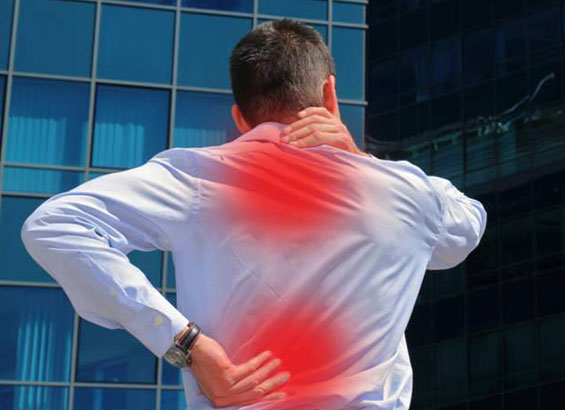There are an array of neck and back injuries that can occur because of an accident or other traumatic experience. Injuries can range from muscle spasms and soft tissue strains to herniated disks and fractures. The symptoms can range from mild, dull, annoying ache, to persistent, severe, disabling pain. Pain in your back can restrict mobility and interfere with normal functioning and quality of life.
Neck and back injuries can occur anywhere along the spinal canal which consists of the cervical, thoracic, and lumbar regions that run from the base of your neck to the top of the buttock. These flexible bony structures, called vertebra, are well engineering houses for nerves, muscles, ligaments, and tendons to attach. The vertebras are sandwiched between strong flexible tissues of fibrocartilage called discs that help give movement and space to the spinal column.

Even with advances in medical technology and diagnostic equipment, the exact cause of back and neck pain is difficult to decipher. Following an accident, a person may feel tension, spasm, numbness, shooting pain or even stabbing pain that are both localized and travel down their extremities. Through x-rays, CT Scans, MRIs, nerve conduction studies, EMGs, and other diagnostic tools and examinations, a trained medical profession should be able to assess the cause of those symptoms. Some of the more common causes include:
If you experience acute back or neck pain as a result of an accident or trauma, it may simply improve with some rest and over-the-counter medication such as Tylenol or ibuprofen. Regardless, clinical and medical assessment should not wait as the underlying symptoms may cause a far greater consequence if you want to long. A whiplash injury may turn into a stroke if the accident resulted in a tear to an artery or vein in the spinal column. Immediate medical attention should always be sought.
Even after initial treatment, the symptoms may persist. Several non-invasive treatment options exist to address the symptoms including:
Sometimes, however, these more conservative treatment options do not resolve the symptoms due to the chronic underlying condition and surgical intervention become necessary. For example, if the back pain is from a herniated disc or other nerve root compression, surgery may be the only remaining course of treatment. Common procedures to address spinal column back and neck injuries include:
NOTE: THERE ARE A BUNCH OF VIDEOS AND PHOTOS THAT CAN BE FOUND AT http://drdillin.com/surgical-spine-procedures/ THAT MAYBE CAN BE INCORPORATED.
If you were damaged due to someone else’s carelessness or negligence, you may be entitled to money to cover not only the significant cost of past and future medical treatment, but possibly lost wages and other damages. You also may be paid for the physical pain and emotional suffering resulting from this debilitating injury. Our firm’s outstanding success and reputation with spine injuries cases is due to the considerable care and attention we give in identifying the responsible parties, the cause of the symptom, and directing appropriate and reasonable treatment options. Our team will stand with you and see you through all the ups and down in the recovery process. Call us if you would like to learn more about how we can help.
